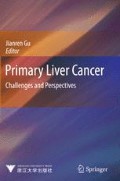Abstract
Liver is regarded as a tolerogenic organ, and long-term persistence of hepatitis B and C viruses in the liver has been suggested to be partially due to the liver immunosuppressive or tolerogenic microenvironment. It is well known that hepatitis B and C viruses are associated with the development of hepatocellular carcinoma (HCC) in the later stages, and HCC cells develop many strategies to evade immunosurveillance or immunological attack. In this chapter we will summarize the recent advances in the identification and functional study of suppressive immune cells in liver microenvironment and investigate how they contribute to the HCC immunosuppressive microenvironment. Then we will introduce the development of effective approaches to induce immune responses to HCC.
Access this chapter
Tax calculation will be finalised at checkout
Purchases are for personal use only
Preview
Unable to display preview. Download preview PDF.
References
Wakabayashi M, Shiro T, Seki T, et al. Antigen expression in hepatocellular carcinoma. An immunohistochemical study. Cancer, 1995, 75: 2827–2835.
Dong X Y, Yang X A, Wang Y D, et al. Zinc-finger protein ZNF165 is a novel cancer-testis antigen capable of eliciting antibody response in hepatocellular carcinoma patients. Br J Cancer, 2004, 91: 1566–1570.
Yin Y H, Li Y Y, Qiao H, et al. TSPY is a cancer testis antigen expressed in human hepatocellular carcinoma. Br J Cancer, 2005, 93: 458–463.
Li B, Wang Y, Chen J, et al. Identification of a new HLA-A*0201-restricted CD8+ T cell epitope from hepatocellular carcinoma-associated antigen HCA587. Clin Exp Immunol, 2005, 140: 310–319.
Ito H, Funahashi S, Yamauchi N, et al. Identification of ROBO1 as a novel hepatocellular carcinoma antigen and a potential therapeutic and diagnostic target. Clin Cancer Res, 2006, 12: 3257–3264.
Nishimura Y, Nakatsura T, Senju S. Usefulness of a novel oncofetal antigen, glypican-3, for diagnosis and immunotherapy of hepatocellular carcinoma. Nihon Rinsho Meneki Gakkai Kaishi, 2008, 31: 383–391.
Stoop J N, van der Molen R G, Baan C C, et al. Regulatory T cells contribute to the impaired immune response in patients with chronic hepatitis B virus infection. Hepatology, 2005, 41: 771–778.
Unitt E, Rushbrook S M, Marshall A, et al. Compromised lymphocytes infiltrate hepatocellular carcinoma: the role of T-regulatory cells. Hepatology, 2005, 41: 722–730.
Kobayashi N, Hiraoka N, Yamagami W, et al. FOXP3+ regulatory T cells affect the development and progression of hepatocarcinogenesis. Clin Cancer Res, 2007, 13: 902–911.
Fu J, Xu D, Liu Z, et al. Increased regulatory T cells correlate with CD8 T-cell impairment and poor survival in hepatocellular carcinoma patients. Gastroenterology, 2007, 132: 2328–2339.
Sancho D, Gomez M, Viedma F, et al. CD69 downregulates autoimmune reactivity through active transforming growth factor-beta production in collagen-induced arthritis. J Clin Invest, 2003, 112: 872–882.
Han Y, Guo Q, Zhang M, et al. CD69+ CD4+ CD25− T cells, a new subset of regulatory T cells, suppress T cell proliferation through membrane-bound TGF-beta 1. J Immunol, 2009, 182: 111–120.
Ilkovitch D, Lopez D M. The liver is a site for tumor-induced myeloid-derived suppressor cell accumulation and immunosuppression. Cancer Res, 2009, 69: 5514–5521.
Li H, Han Y, Guo Q, et al. Cancer-expanded myeloid-derived suppressor cells induce anergy of NK cells through membrane-bound TGF-beta 1. J Immunol, 2009, 182: 240–249.
Hoechst B, Ormandy L A, Ballmaier M, et al. A new population of myeloid-derived suppressor cells in hepatocellular carcinoma patients induces CD4+CD25+FOXP3+ T cells. Gastroenterology, 2008, 135: 234–243.
Budhu A, Forgues M, Ye Q H, et al. Prediction of venous metastases, recurrence, and prognosis in hepatocellular carcinoma based on a unique immune response signature of the liver microenvironment. Cancer Cell, 2006, 10: 99–111.
Kuang D M, Wu Y, Chen N, et al. Tumor-derived hyaluronan induces formation of immunosuppressive macrophages through transient early activation of monocytes. Blood, 2007, 110: 587–595.
Kuang D M, Zhao Q, Peng C, et al. Activated monocytes in peritumoral stroma of hepatocellular carcinoma foster immune privilege and disease progression through PD-L1. J Exp Med, 2009, 206: 1327–1337.
Kuang D M, Peng C, Zhao Q, et al. Activated monocytes in peritumoral stroma of hepatocellular carcinoma promote expansion of memory T helper 17 cells. Hepatology, 2010, 51: 154–164.
You H, Ding W, Rountree C B. Epigenetic regulation of cancer stem cell marker CD133 by transforming growth factor-beta. Hepatology, 2010, 51: 1635–1644.
Naugler W E, Sakurai T, Kim S, et al. Gender disparity in liver cancer due to sex differences in MyD88-dependent IL-6 production. Science, 2007, 317: 121–124.
Park E J, Lee J H, Yu G Y, et al. Dietary and genetic obesity promote liver inflammation and tumorigenesis by enhancing IL-6 and TNF expression. Cell, 2010, 140: 197–208.
Author information
Authors and Affiliations
Rights and permissions
Copyright information
© 2012 Zhejiang University Press, Hangzhou and Springer-Verlag Berlin Heidelberg
About this chapter
Cite this chapter
Wang, Q., Cao, X. (2012). Immunosuppresssion and Immune Escape in Liver Cancer. In: Primary Liver Cancer. Springer, Berlin, Heidelberg. https://doi.org/10.1007/978-3-642-28702-2_9
Download citation
DOI: https://doi.org/10.1007/978-3-642-28702-2_9
Publisher Name: Springer, Berlin, Heidelberg
Print ISBN: 978-3-642-28701-5
Online ISBN: 978-3-642-28702-2
eBook Packages: MedicineMedicine (R0)

